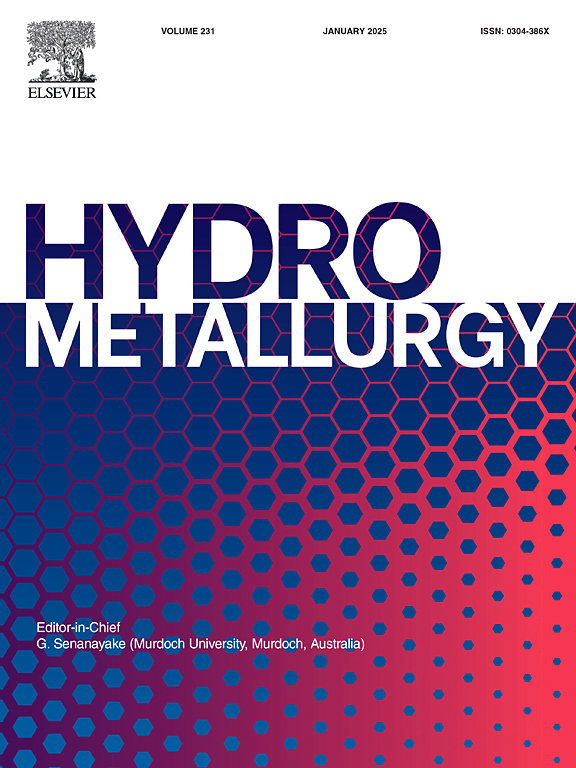Recovery of copper oxide from e-waste using ashing, size reduction, nitric acid leaching, solvent extraction and stripping-precipitation: Parametric and scaling up studies and fate of scarce metals
IF 4.8
2区 材料科学
Q1 METALLURGY & METALLURGICAL ENGINEERING
引用次数: 0
Abstract
Copper recovery from electronic waste in the form of copper oxide was investigated using hydrometallurgy-based process. The recovery process involved dismantling of electronic components, their size reduction, ashing at 600 °C for 4 h to disintegrate the polymer matrix to facilitate metal recovery and remove volatiles as pretreatment, followed by nitric acid leaching, solvent extraction of leachate, and precipitation-stripping with oxalic acid to obtain copper oxalate. Controlled calcinations of the oxalate yielded the valuable copper oxide. Copper concentration in e-waste was found to vary with feed size. Maximum copper concentration of 43.1 % (w/w) was found in the size range of 0.5 mm to 0.355 mm. Maximum leaching of copper (98.7 %) occurred at solid to liquid (S/L) ratio (g/mL) of 1:25 using 10 % nitric acid at 60 °C. For an initial leachate concentration of 30 g/L copper, using 10 % v/v LIX 984 N as the extractant at an organic to aqueous (O/A) phase volume ratio of 1.25:1 resulted in quantitative copper extraction in three stages. Oxalic acid (1 M) was used to strip and precipitate the copper extracted resulting in 99.8 % metal recovery. Scale up of the process did not alter the recoveries. The copper oxide obtained was 99.65 % pure with trace impurities of aluminium and iron. This process aims to achieve high copper recovery while addressing environmental concerns and optimizing resource efficiency, offering potential applications in large-scale electronic waste recycling for valuable metal recovery.

利用灰化、还原、硝酸浸出、溶剂萃取和汽提沉淀法从电子垃圾中回收氧化铜:参数化和规模化研究以及稀有金属的命运
研究了以氧化铜形式从电子垃圾中回收铜的湿法冶金工艺。回收过程包括拆解电子元件、缩小电子元件尺寸、600℃灰化4 h分解聚合物基体以促进金属回收和去除挥发物作为预处理,然后进行硝酸浸出、浸出液溶剂萃取、草酸沉淀—汽提得到草酸铜。控制草酸盐的煅烧得到有价值的氧化铜。发现电子垃圾中的铜浓度随进料大小而变化。在0.5 mm ~ 0.355 mm范围内,铜的最大浓度为43.1% (w/w)。在固液比(S/L) (g/mL)为1:25时,使用10%的硝酸在60℃下,铜的最大浸出率为98.7%。对于铜初始浓度为30 g/L的渗滤液,采用10% v/v LIX 984 N作为萃取剂,在有机与水相(O/A)体积比为1.25:1的条件下,分三段定量提取铜。采用草酸(1m)对铜进行剥离沉淀,金属回收率为99.8%。这一过程的规模扩大并没有改变经济复苏。所得氧化铜纯度为99.65%,并含有微量的铝和铁杂质。该工艺旨在实现高铜回收率,同时解决环境问题和优化资源效率,为大规模电子废物回收有价金属提供潜在应用。
本文章由计算机程序翻译,如有差异,请以英文原文为准。
求助全文
约1分钟内获得全文
求助全文
来源期刊

Hydrometallurgy
工程技术-冶金工程
CiteScore
9.50
自引率
6.40%
发文量
144
审稿时长
3.4 months
期刊介绍:
Hydrometallurgy aims to compile studies on novel processes, process design, chemistry, modelling, control, economics and interfaces between unit operations, and to provide a forum for discussions on case histories and operational difficulties.
Topics covered include: leaching of metal values by chemical reagents or bacterial action at ambient or elevated pressures and temperatures; separation of solids from leach liquors; removal of impurities and recovery of metal values by precipitation, ion exchange, solvent extraction, gaseous reduction, cementation, electro-winning and electro-refining; pre-treatment of ores by roasting or chemical treatments such as halogenation or reduction; recycling of reagents and treatment of effluents.
 求助内容:
求助内容: 应助结果提醒方式:
应助结果提醒方式:


